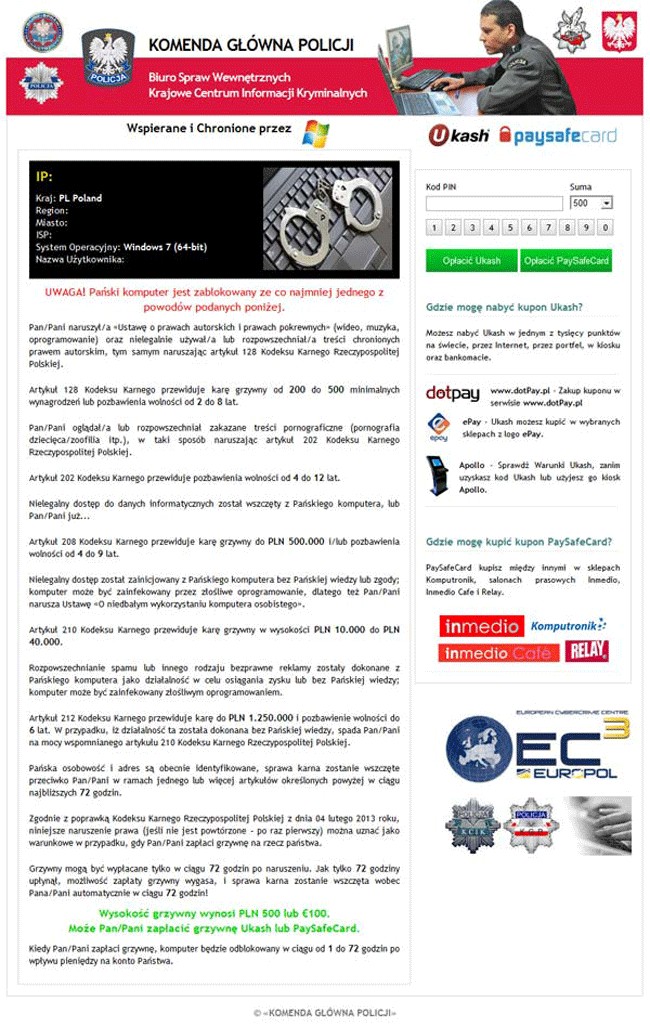KOMENDA GLOWNA POLICJI Ransomware
Threat Scorecard
EnigmaSoft Threat Scorecard
EnigmaSoft Threat Scorecards are assessment reports for different malware threats which have been collected and analyzed by our research team. EnigmaSoft Threat Scorecards evaluate and rank threats using several metrics including real-world and potential risk factors, trends, frequency, prevalence, and persistence. EnigmaSoft Threat Scorecards are updated regularly based on our research data and metrics and are useful for a wide range of computer users, from end users seeking solutions to remove malware from their systems to security experts analyzing threats.
EnigmaSoft Threat Scorecards display a variety of useful information, including:
Ranking: The ranking of a particular threat in EnigmaSoft’s Threat Database.
Severity Level: The determined severity level of an object, represented numerically, based on our risk modeling process and research, as explained in our Threat Assessment Criteria.
Infected Computers: The number of confirmed and suspected cases of a particular threat detected on infected computers as reported by SpyHunter.
See also Threat Assessment Criteria.
| Threat Level: | 100 % (High) |
| Infected Computers: | 4 |
| First Seen: | February 26, 2013 |
| Last Seen: | July 23, 2019 |
| OS(es) Affected: | Windows |

KOMENDA GLOWNA POLICJI Ransomware Image
Police Ransomware infections have been on the increase since 2009. During 2012, these kinds of scams spread throughout the world (until then they'd been confined to European targets). This is not surprising since the Police Ransomware represents a huge source of profits for criminal organizations. The KOMENDA GŁÓWNA POLICJI Ransomware variant targets computer users in Poland. According to ESG security researchers, the KOMENDA GŁÓWNA POLICJI Ransomware Trojan uses the same scam that has been observed countless other times in Police Ransomware infections.
Table of Contents
The KOMENDA GŁÓWNA POLICJI Ransomware Mimics the Polish Police
Police Ransomware attacks are often restricted to a single country or geographical region. The Police Ransomware's installer detects the infected computer's IP address and then installs a variant of this scam that corresponds to that country. KOMENDA GŁÓWNA POLICJI Ransomware infects computers with a Polish IP address. Computers in other countries will usually be infected with other variants of this threat. The differences between each variant are mainly in the ransomware message used. The KOMENDA GŁÓWNA POLICJI Ransomware message is written in Polish, makes claims that are supposedly sent by Poland's police to the victim, and includes pictures and logos of Poland's police.
Understanding the KOMENDA GŁÓWNA POLICJI Ransomware Scam
Scams like the KOMENDA GŁÓWNA POLICJI Ransomware Trojan are designed to scare the victim into paying a fine, in this case of one hundred Euros. The KOMENDA GŁÓWNA POLICJI Ransomware message threatens the victim with jail time, pretending to be from the police and accusing the victim of viewing pornographic material, copyrighted content and of online harassment. Inexperienced computer users may fall for the trap, believing that the police uses tactics like locking computer users and displaying messages like the one used by the KOMENDA GŁÓWNA POLICJI Ransomware infection. Unfortunately for victims of the KOMENDA GŁÓWNA POLICJI Ransomware scam, the real danger in these kinds of infections is a Winlocker component.
The KOMENDA GŁÓWNA POLICJI Ransomware Winlocker
The KOMENDA GŁÓWNA POLICJI Ransomware infection uses a Winlocker to prevent the victim from accessing their computer. This malicious infection blocks access to the infected computer's Desktop and, therefore, to all files and applications on the victim's computer. KOMENDA GŁÓWNA POLICJI Ransomware also blocks access to the Task Bar, Start Menu, Task Manager and to Safe Mode in severe infections. Because of this, removal of KOMENDA GŁÓWNA POLICJI Ransomware will often require alternate start-up methods to get at the Windows Registry Editor or security software installed on the infected computer.



Submit Comment
Please DO NOT use this comment system for support or billing questions. For SpyHunter technical support requests, please contact our technical support team directly by opening a customer support ticket via your SpyHunter. For billing issues, please refer to our "Billing Questions or Problems?" page. For general inquiries (complaints, legal, press, marketing, copyright), visit our "Inquiries and Feedback" page.